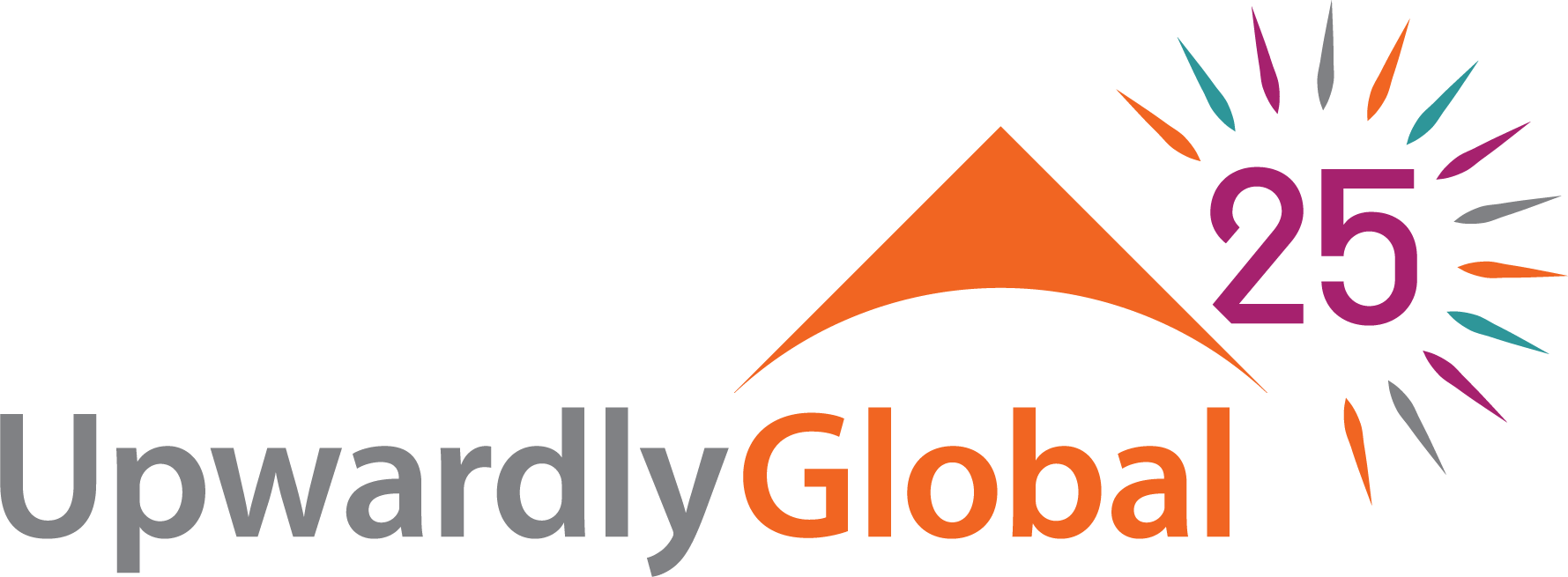Below and linked here is a set of recommendations that Upwardly Global shared with the Task Force on New Americans, which was established by the Biden Administration in December 2022 and for which Upwardly Global and allies — led by Welcoming America and NPNA — had advocated over the last year.
The recommendations have been sourced from our staff and community, who we thank, and are based on over 20 years of experience working with immigrant and refugee professionals. Our hope is that the task force will move policy from the recommendations stage to implementation. We know that the government is able to enact critical policies that can meaningfully support our community and create systemic change and opportunity.
Recent high-profile migrations from Afghanistan, Ukraine, and Latin America have pointed a spotlight on inadequacies in our current systems for immigrant and refugee inclusion. Upwardly Global believes that workforce inclusion at each newcomer’s skill level is a key to improving the way that we support them. When done right, immigrant workforce inclusion can unlock a double win: offering newcomers a path to supporting themselves, their families, and their communities with dignity, and, in tandem, adding billions of dollars in value to our economy that increases shared prosperity. Persistent, long-term domestic labor market needs, including those in the mid- and high-skill level sectors in healthcare, broad-based technology (as all businesses build tech units), and beyond, underscore the timeliness of these efforts.
Upwardly Global is the first and largest national organization to support immigrant and refugee professionals. We have worked on the ground with over 20,000 immigrants and refugees with international credentials in order to match them with skill-aligned jobs in high-demand industries, such as healthcare, tech, finance, engineering, and business operations. In 2022, our job seekers earned an average starting salary of over $67,000, representing an average income increase of nearly $60,000; during the year, our alumni added over $600 million to the U.S. economy in combined wages.
Below are responses to the questions posted by the Workforce Training and Development Subcommittee of the Task Force on New Americans based on our decades-long, on-the-ground work in this field with immigrant and refugee professionals.
I. What are the top three barriers new Americans face integrating into our nation’s workforce?
Today, 2.3 million immigrants and refugees with foreign credentials are unemployed or underemployed while our economy has millions of openings in areas where they would bring professional strength and expertise. This is the population that Upwardly Global has worked with for over 20 years and knows best. Critical barriers they face include:
1. Career navigation: Newcomers are solely challenged to understand what jobs they qualify for, how their skills fit into the labor market, whether they need to relicense or re-credential, and what that career pathway journey might look like. Regulated industries such as medicine, legal, engineering, accounting, and teaching have licensing requirements that differ by state, and the requirements change regularly. Some industries, such as technology, are more skills-based and rely less on credentials, but without U.S. work experience, a U.S. credential or certification is often required. Being able to navigate career paths, skilling options, and job opportunities requires navigation support.
2. Rapid-attachment employment: Many of the job seekers we work with go to job centers but do not find any services relevant to their individual skill level. Most of the country’s resettlement and workforce systems chase “rapid attachment” low-wage jobs for immigrants and refugees. We see tremendous diversity — in academic training, occupation, cultural awareness, and intersectional identities — among newcomers, with some 45% having a bachelor’s degree or higher; it is therefore important to take stock of a newcomer’s skills, background, and credentials while supporting them into jobs that have advancement prospects. Otherwise, they are trapped in quickly acquired, low-paying jobs that sorely lack long-term opportunities and upward mobility.
3. Language skills: English is a common barrier for immigrant professionals. Basic language skills are critical for those who do not possess them, as well as professional and industry-specific English for individuals looking to obtain mid-level jobs. Quality language programs are often expensive, and professional-level English training for adults are few and far between. In Upwardly Global’s 2023 report, “Roadblocks to Workforce Inclusion for Young Adult Immigrants,” only 22% of respondents mention English proficiency as a barrier; however, 43% requested targeted English language support to address cultural differences, industry lingo, and professional communication. There is also the need to touch on cultural differences as we support refugees and immigrants up the economic career ladder.
II. How can the U.S. government best address each of these areas?
1. Support quality career navigation programs by:
- Investing in career navigator programs that can support entry-level and mid-skill newcomer talent. These should include differentiated career pathways for entry-level and mid-skill talent with re-credentialing/relicensing and re/upskilling needs. Wrap-around services in job-readiness training, mentorship programs, and credential evaluations can increase economic outcomes as well.
- Innovating new technologies that can be used to scale this work, such as artificial intelligence solutions.
- Mandating states to issue licensing guides for regulated industries and update them regularly. In partnership with Latham and Watkins law firm, Upwardly Global has drafted a number of professional licensing guides for immigrant professionals. Overall, international credentials need to be valued and recognized.
2. Shift current incentive structures for workforce agencies and job centers that focus on rapid-attachment jobs. The federal government can, instead, explicitly make funding available to organizations that help individuals land mid-skill jobs with opportunities for advancement. This should include differentiated services for newcomers with prior professional experience and education.
There are multiple ways that the federal government can direct services to alter this dynamic, such as:
- Open and direct Workforce Innovation and Opportunity Act (WIOA) funds to programs that service immigrant and refugee professionals, and ensure that requirements do not lock out this community by including items such as “accepting first offers” and reevaluating eligibility criteria based on visa status and income level.
- Increase this community’s eligibility for Perkins loans and direct federal funding to incentivize community colleges to include immigrant and refugee workforce preparation, open to multiple visa categories.
- Ensure that the equitable workforce-hiring and job-creation mandates that are included in the over $2 trillion new Federal funding for green transition, CHIPS research, and other critical investments include immigrants and refugees as a priority/preferential population.
- Support funding for state Offices of New Americans (ONA) and highlight state efforts that move the bar on mid-skill employment, including cooperation with career navigator programs (the ONA in New York has a trailblazing program to build capacity for this work, run in cooperation with Upwardly Global) and coordination of resources available for wrap-around support services (such as in Maryland — see below).
- Reduce red tape for apprenticeship models, and add on mid-skill apprenticeships for mid-skill professionals reentering the workforce.
3. Support quality English language programs, with a specific focus on industry-relevant skills, to enable immigrant professionals to land skill-aligned work. These courses can be supported through community colleges or through nonprofits such as Riverside Languages. One of the best examples is New York University’s targeted English language courses for refugee professionals.
III. How might the U.S. government best ensure new Americans know available workforce and job-training programs and their workers’ rights?
Newcomer task forces or workforce working groups, staffed by and organized through state agencies with programming and info sharing led by on-the-ground practitioners within the region, can coordinate and address service gaps through effective referral systems, and ensure that people are not locked out of opportunity for lack of accurate and available information — for example, the State of Maryland Skilled Immigrant Task Force (part of the Division of Workforce Development and Adult Learning, Maryland Department of Labor).
IV. What are data and information gaps relating to new Americans and their integration into our nation’s workforce that you would like to see the U.S. government address?
Today, there is no system to collect and understand — on any level — the skills and backgrounds that immigrants and refugees bring to the U.S. Standardizing data collection among agencies that work with this population in ways that do not compromise confidentiality is critical so that we can design and support appropriate systems and programs that better connect new Americans to jobs at their skill levels, thereby adding to immigrant inclusion to the U.S. economy and workforce.
USCIS is a natural entry point as most immigrants need to go through USCIS for paperwork, work authorization, or visa status changes and renewals. Coordinating with this federal agency — to collect robust data and support information sharing as a one-stop shop — might be an effective way.
These efforts can also go a long way in building public support of immigrants and refugees as part of our economic engine, and may be a key to shared opportunity and prosperity. The data collected should be intersectionally disaggregated by gender, race/color, and ethnicity. In addition, many Arabs are told to list themselves as “white”; another nativity category should be considered for this community.
Finally, in order to better build confidence with the business community, it is important to track the length of time it realistically takes to renew work authorization, ensure legal pathways for those with work beyond their 2-year work authorization status, and shift application times for timely renewals. For example, work authorization renewal can be applied for 180 days before it expires; however, it can take over 5 months to receive, which results in individuals being fired and reduces the likelihood of companies to take on this risk.
V. What tools, mechanisms, or partnerships should the U.S. government establish to help new Americans integrate into our nation’s workforce?
Establishment of a New Americans Advisory Council. To ensure ongoing stakeholder engagement and public narrative, there should be an established New Americans Advisory Council responsible for advising the task force and its activities. The members should be appointed by the Domestic Policy Council and should include representatives from state and local government, immigrant advocacy organizations, community service providers, and other organizations and individuals. The goals of such groups should include enhancing the visibility and funding of solutions that address the challenges skilled immigrants face, consolidating career navigator programs and other support resources that have proven effective in reducing barriers to skill-aligned workforce inclusion, and engaging with businesses and the private sector.
We hope that the Department of Labor, working with this task force, can also use the upcoming study mandated by the Bridging the Gap for New Americans Act on skilled immigrant workforce integration to highlight these gaps and propose long-term solutions.
Contact: Jina Krause-Vilmar, President and CEO, Upwardly Global, jina@upwardlyglobal.org
Upwardly Global is a U.S.-based nonprofit focused on eliminating employment barriers for immigrant and refugee professionals and advancing the inclusion of their skills into the economy.
###


